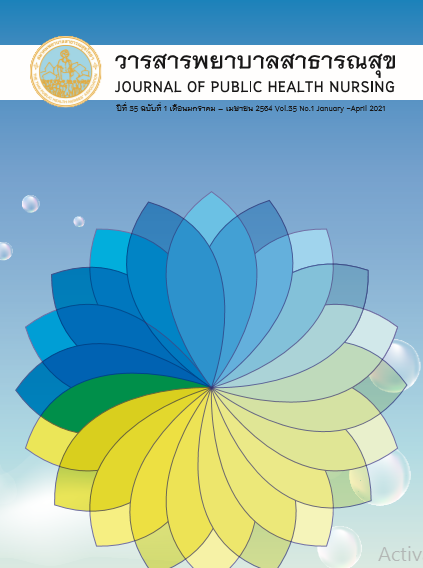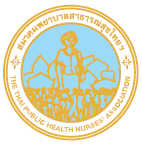The Caring Model development of Neonatal Sepsis at Somdet Phra Phutthaloetla Hospital in Samutsongkhram Province
Keywords:
Care Model, Neonate, SepsisAbstract
Sepsis is life-threatening for neonates. Their care needs an appropriate model and clear nursing guidelines. This action research aims to develop a care model for neonatal sepsis at Somdet Phra Phutthaloetla Hospital, and examine care outcomes based on both Donabedian’s model and the Iowa model of evidence-based practice. Subjects were 71 nurses, 86 live births and 11 neonates who were diagnosed with neonatal sepsis. The research progressed sequentially through the following four steps: 1) Situation analysis 2) Model development for clinical nursing 3) Implementation of the Model in Actual Cases, and 4) Evaluation of the Model Outcomes. Research tools included: A review of medical record forms for neonatal sepsis, a questionnaire of care situations for neonatal sepsis, a knowledge test for those who treat neonatal sepsis, a satisfaction assessment form to evaluate the care model, data collection assessment through neonate data forms and evaluation results during and after implementation. Data were analyzed using content analysis, descriptive statistics, and paired t–test.
The results showed a care model for neonatal sepsis with 3 components: The first component was a structure that included set policies and goals, development of registered nurses’ knowledge, and management of medical equipment. The second component was a process including identification of neonatal sepsis with neonates at high risk, identification of the pathogen, the source of infection and infection control, resuscitation of the circulatory system, organ support with intensive monitoring, and multidisciplinary care for neonatal sepsis with follow-up practice. The third component was the outcome for patients and nurse practitioners after using the care model. Outcomes of the development indicated that the patient’s incidence of severe sepsis and septic shock was 9.09; the mortality rate was 0. Nurses had increased mean scores of knowledges (p < 0.05); good levels in practice. Nurse satisfaction with the care model was very good. The neonatal sepsis care model’s development was appropriate to its specific context, increased knowledge of nurses, and applicable in the work process to reduce mortality rate from neonatal sepsis. This model is recommended for further application for high- quality nursing development.
References
Simonsen KA, Ann L, Anderson-Berry B, Shirley F, Delair AH, Davies D. Early-Onset Neonatal Sepsis. Clinical Microbiology Reviews 2014; 27(1): 21-47.
Tesini BL. Neonatal sepsis: MSD Manual Version [Internet]. 2018 [cited 2020 July]. Available from: https://www.msdmanuals.com/professional/pediatrics/infections-in-neonates/neonatal-sepsis
Kardana IM. Incidence and factors associated with mortality of neonatal sepsis. Pediatric indonesiana 2011; 51(3): 144-8.
Jajoo M, Kapoor K, Garg K, Manchanda V, Mittal SK. To study the incidence and risk factors of early onset neonatal sepsis in an out born neonatal intensive care unit of India. Clinical neonatology 2015; 4(2): 91-5.
Procianoy RS, Silveira RC. The challenges of neonatal sepsis management. J Pediatr 2019; 96(S1): 80-6.
Palatnik A, Liu LY, Lee A, Yee LM. Predictors of Early-Onset Neonatal Sepsis or Death Among Newborns Born at <32 Weeks of Gestation. Perinatology 2019; 39(7): 949-55.
Berardi A, Sforza F, Baroni L, Spada C, Ambretti S, Biasucci G, et al. Epidemiology and complications of late-onset sepsis: an Italian area-based study.PLoS ONE 2019: 14(11):1-15.
Kiatchoosakun P, Jirapradittha J, Areemitr R, Sutra S, Thepsuthammarat K. Current Challenges in Reducing Neonatal Morbidity and Mortality in Thailand. J Med Assoc Thai 2012; 95(S7): 18-23. (in Thai).
Bureau of Policy and Strategy, Ministry of Public Health. Study report: maternal and infant mortality 2011-2015 [Internet]. 2016 [cited 2020 July 10] Available from: http://ihppthaigov.net/DB/publication/attachresearch/402/chapter1.pdf
Wijugprasert P. Pediatric septic shock at Maharat Nakhon Ratchasima Hospital. Thai journal of pediatrics 2014; 53(1): 43-51. (in Thai).
Husada D, Chanthavanich P, Chotigeat U, Sunttarattiwong P, Sirivichayakul C, Pengsaa K, et al. Predictive model for bacterial late-onset neonatal sepsis in a tertiary care hospital in Thailand. BMC Infectious Diseases 2020;20: 1-11.
Sharma A, Mathur P, Sharma JN, Gupta M, Agarwal A. Neonatal Sepsis - A Study of Predisposing Factors and Causative Organisms. Scholars Journal of Applied Medical Sciences 2020; 8(10): 2256-9.
The Thai Society of Pediatric Respiratory and Critical Care Medicine. Clinical Practice Guideline for Management of Pediatric Severe Sepsis and Septic Shock [Internet]. 2018 [cited 2020 December 16]. Available from: https://www.thaipediatrics.org
Rodjinda S. Development of Caring Model for Sepsis Patients in the Medical Wards, Nan Hospital. Nursing Journal of the Ministry of Public Health 2019; 30(1): 120-34.
Gale BM, Hall KK. The Use of Patient Monitoring Systems to Improve Sepsis Recognition and Outcomes: A Systematic Review. Journal of Patient Safety 2020; 16(Suppl): S8-11
Sunthornkulwong M. Developing a surveillance system and assessing early-onset neonatal sepsis in special ward of Jainadnarendra hospital [Internet]. 2018 [cited 2020 December 16]. Available from: http://www.chainathospital.org/.
Donabedian A. An introduction to quality assurance in health care. Oxford: Oxford University Press; 2003.
Titler MG, Kleiber FC, Steelman VJ, Rakel BA, Budreau G, EverettL Q, et al. The Iowa model of evidence–based practice to promote quality care. Critical Care Nursing Clinics of North America 2001; 13(4): 497–509.
Picheansathian W. Searching for Evidence: Essential Skills of Nurses in Thailand 4.0 Thai. Journal of Nursing and Midwifery Practice 2018; 5(1): 136-48. (in Thai).
The Joanna Briggs Institute [Internet]. 2014 [cited 2020 August 5]. Available from: http://www.joannabriggs.org/assets/docs/sumari/reviewersmanual
Kirdpole W. Developing a clinical nursing practice guidelines for prevention atelectasis in preterm neonate using ventilator. Faculty of Nursing Khon Kaen University; 2008. (in Thai).
Cahyono A. The Cause of Mortality Among Congenital Heart Disease Patients in Pediatric Ward, Soetomo General Hospital. Indonesian Journal of Cardiokog 2007; 28(4), 279-84.
Weiss SL. Clinical update in pediatric sepsis: focus on children with pre-existing heart disease. Cardiothorac Vasc Anesth 2020; 34(5): 1324-32.
Phokapun P, Leethongdee S, Tikkapanyo C. The Quality Improvement of Clinical Risk Management System for Care Standard of In-Patient Care of Nurses in the Fort Sunpasitthiprasong Hospital in Ubon Ratchathani Province.The Royal Thai Army Nurses 2012; 13(2): 31-48. (in Thai).
Chompoolong S, Suwalaya Sriruksa S. The Development Nursing Service System of Preterm Infant in Mahasarakham Hospital and Network. Nurses’ association of Thailand, North-Eastern division 2013; 31(2): 151-64. (in Thai).
Downloads
Published
How to Cite
Issue
Section
License
บทความที่ตีพิมพ์และแผนภูมิรูปภาพถือเป็นลิขสิทธิ์ของวารสารพยาบาลสาธารณสุข (Thai Public Health Nurses Association)







